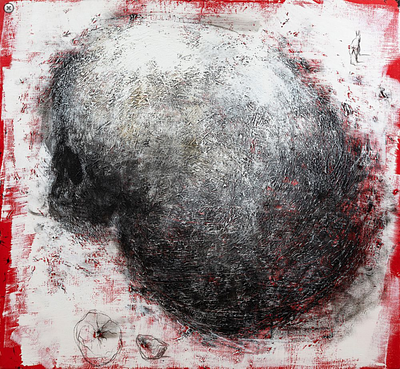MIQUEL BARCELÓ ARTIGUES (Felanitx, Mallorca, 1957). "Crâne à l'Âne", 2006. Mixed media on canvas. Signed, dated and titled on the back. With label
Lot 93
About Seller
Setdart Auction House
Carrer Aragó 346
Barcelona
Spain
Setdart Subastas was born in 2004 and is currently the first online art auction in Spain with solidity, prestige and reliability guaranteed by our more than 60,000 users. Setdart has a young, dynamic and enterprising team ready to successfully manage the purchase and sale of art works through custom...Read more
Categories
Estimate:
EUR€300,000 - EUR€350,000
$322,580.65 - $376,344.09
Absentee vs Live bid
Two ways to bid:
- Leave a max absentee bid and the platform will bid on your behalf up to your maximum bid during the live auction.
- Bid live during the auction and your bids will be submitted real-time to the auctioneer.
Bid Increments
| Price | Bid Increment |
|---|---|
| EUR€0 | EUR€10 |
| EUR€200 | EUR€25 |
| EUR€500 | EUR€50 |
| EUR€1,000 | EUR€100 |
| EUR€3,000 | EUR€200 |
| EUR€5,000 | EUR€500 |
| EUR€10,000 | EUR€1,000 |
| EUR€20,000 | EUR€2,000 |
| EUR€50,000 | EUR€5,000 |
About Auction
By Setdart Auction House
Oct 19, 2021
Set Reminder
2021-10-19 08:00:00
2021-10-19 08:00:00
America/New_York
Bidsquare
Bidsquare : CONTEMPORARY ART
https://www.bidsquare.com/auctions/setdart-auction-house/contemporary-art-7701
Setdart Auction House sofia@setdart.com
Setdart Auction House sofia@setdart.com
- Lot Description
MIQUEL BARCELÓ ARTIGUES (Felanitx, Mallorca, 1957). "Crâne à l'Âne", 2006. Mixed media on canvas. Signed, dated and titled on the back. With label of the Bruno Bischofberger Gallery on the back. Work published in the catalogue of the exhibition "Miquel Barceló", held at the Yvon Lambert Gallery, Paris, from 21 April to 26 May 2007, pp. 20-21. Sizes: 175 x 190 cm. Miquel Barceló offers us a work full of symbolism, a faithful reflection of the pictorial strength and organic drive that defined his unmistakable style. On the one hand, an enormous skull almost completely dominates the pictorial surface, turning its back on us, and reminding us of our human condition. Its material line, full of nuances and sensations, emphasises the concepts of death, disappearance and the passage of time, which acquire absolute relevance in an intense and pure composition, capable of awakening the deepest sensations in the viewer; on the other hand, a donkey moves away from the viewer, a possible allusion to Mallorca, Barceló's native land, where he lives with farm animals. The organic forms arranged on the background, worked in an intense red colour that breaks the monochrome of the rest of the piece, demonstrate his enormous interest in geology, another of Barceló's recurring themes. A painter and sculptor, Barceló began his training at the School of Arts and Crafts in Palma de Mallorca, where he studied between 1972 and 1973. In 1974 he made his individual debut, at the age of just seventeen, at the Galería Picarol in Mallorca. That same year he moved to Barcelona, where he enrolled at the Sant Jordi School of Fine Arts, and made his first trip to Paris. In the French capital he discovered the work of Paul Klee, Fautrier, Wols and Dubuffet, as well as "art brut", a style that was to exert an important influence on his first paintings. During these years he reads extensively, and is enriched by works as diverse as the writings of Breton and the surrealists, Lucio Fontana's "White Manifesto" and Arnold Hauser's "Social History of Literature and Art". In 1976 he held his first solo exhibition in a museum: "Cadaverina 15" at the Museum of Mallorca, consisting of a montage of 225 wooden boxes with glass lids, with decomposing organic materials inside. That same year, back in Mallorca, he joined the Taller Lunàtic group and took part in its social, political and cultural protest actions. In 1977 he made a second trip to Paris, and also visited London and Amsterdam. That same year he exhibits for the first time in Barcelona, and meets Javier Mariscal, who becomes one of his best friends in the city. Together with him and the photographer Antoni Catany, as a member of the group "Neón de Suro", he takes part in exhibitions in Canada and California, and collaborates with the publication of the magazine of the same name. It was also in 1977 that he received his first large-scale painting commission: a mural for the dining room of a hotel in Cala Millor, Mallorca. The following year, at the age of twenty-one, he sold his first works to some collectors and galleries, and finally moved to Barcelona. His international recognition began in the early eighties, giving a definitive boost to his career with his participation in the São Paulo Biennial (1981) and the Documenta in Kassel (1982). In 1986 he was awarded the Premio Nacional de Artes Plásticas, and since then his work has been recognised by the most important awards, such as the Prince of Asturias Prize for the Arts (2003) and the Sorolla Prize of the Hispanic Society of America in New York (2007). Barceló is currently represented in the most important contemporary art museums in the world, such as the MoMA in New York, the Centre Pompidou in Paris, the Guggenheim in Bilbao, the Marugami Hirai in Japan, the Reina Sofía in Madrid, the Patio Herreriano in Valladolid, the CAPC in Bordeaux, the Carré d'Art in Nimes, the Museum of Contemporary Art in Caracas and the Museum of Fine Arts in Boston, among others.
- Shipping Info
-
In-house shipping available. Please inquire at admin@setdart.com.
-
- Buyer's Premium



 EUR
EUR CAD
CAD AUD
AUD GBP
GBP MXN
MXN HKD
HKD CNY
CNY MYR
MYR SEK
SEK SGD
SGD CHF
CHF THB
THB

















